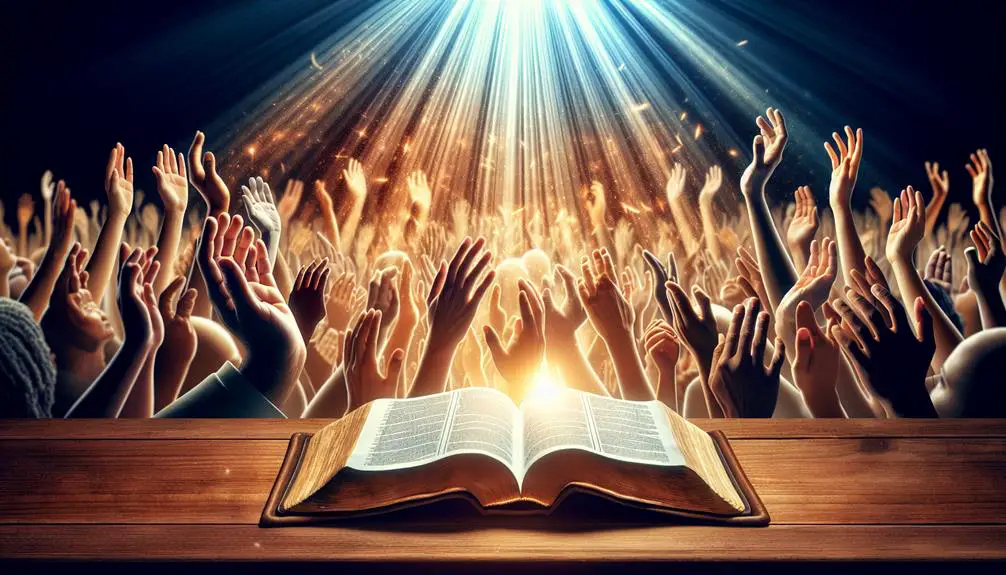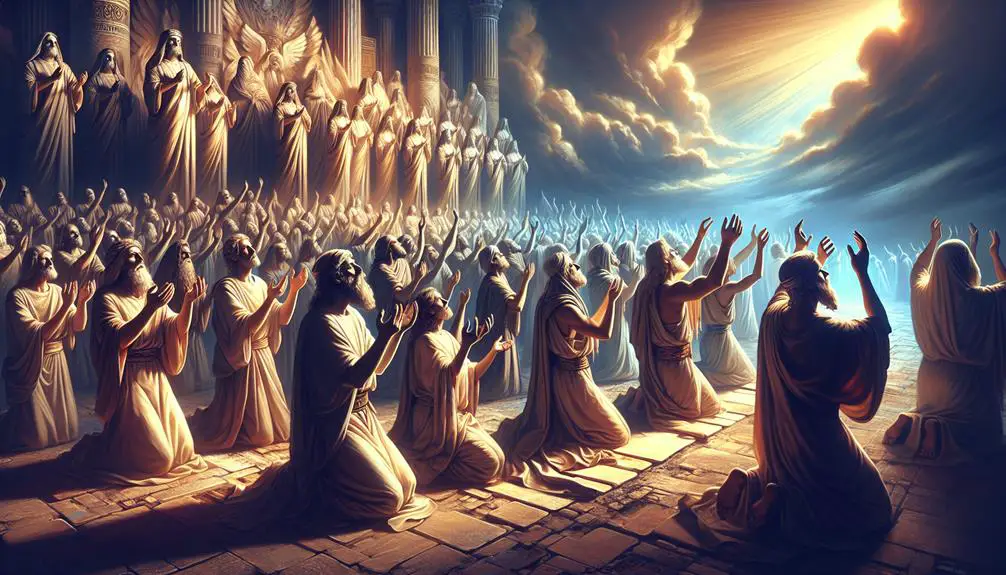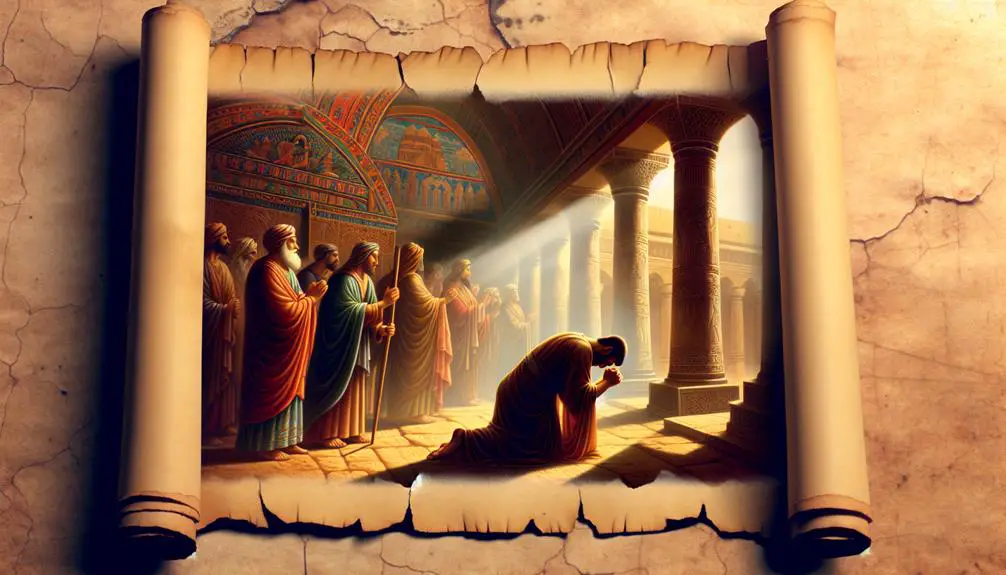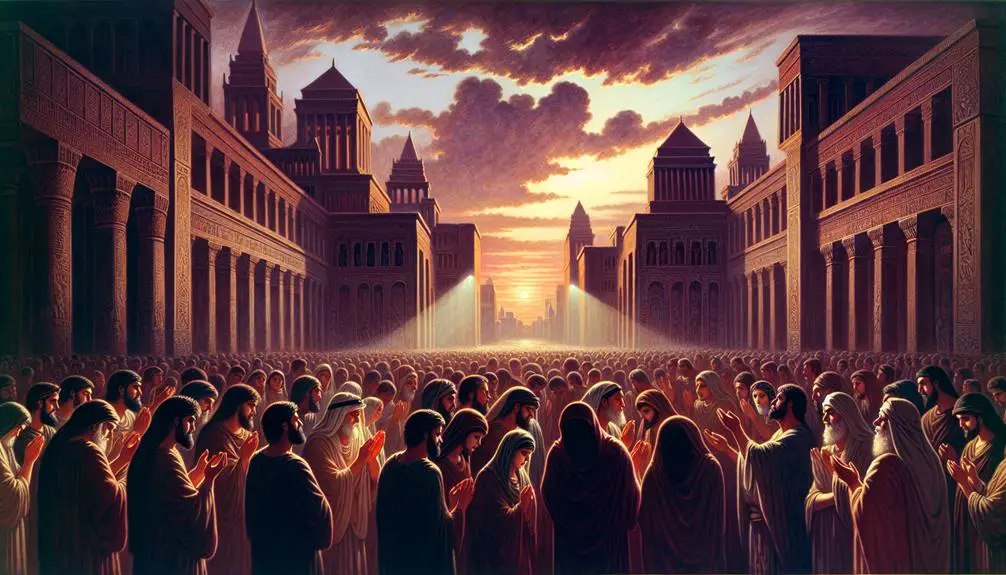Discover how prayers for revival in the Bible illuminate pathways to spiritual renewal, igniting a deeper exploration of faith and transformation.

Prayers for Revival in the Bible
In the tapestry of biblical narratives, prayers for revival stand out as poignant moments where human fragility meets divine intervention. From Solomon's earnest supplication at the dedication of the temple, to Jonah's desperate plea from the belly of a whale, these prayers encapsulate a spectrum of spiritual revival that transcends time and culture.
Each instance not only marks a critical turning point in the biblical story but also offers rich theological insights into the nature of repentance, forgiveness, and renewal. As we explore these prayers, we uncover layers of meaning that challenge and inspire our contemporary understanding of spiritual awakening.
What might these ancient prayers reveal about the dynamics of personal and communal revival today?
Key Takeaways
- Genuine repentance and communal humility are foundational for divine intervention and revival.
- Prayer facilitates spiritual growth, transformation, and a deeper covenant relationship with God.
- Acknowledging wrongdoing, both individually and communally, is crucial for receiving mercy and restoration.
- Spiritual renewal often follows collective actions of repentance, such as fasting and seeking God's forgiveness.
Solomon's Temple Dedication Prayer

At the dedication of Solomon's Temple, King Solomon's prayer exemplifies a profound plea for divine intervention and guidance, embodying a pivotal moment of spiritual renewal and covenantal reaffirmation in the biblical narrative. The Temple construction marked the culmination of Israel's aspirations for a permanent dwelling place for the Divine, symbolizing the nation's zenith in religious, political, and architectural achievements. Solomon's invocation, therefore, was not merely a ritualistic formality but a deeply significant act of consecrating the Sacred architecture to God's service, beseeching His presence and favor upon the people of Israel.
Analyzing the prayer within its scriptural context reveals Solomon's awareness of the Temple's symbolic role as a mediator between the divine and the earthly. The Sacred architecture of the Temple, with its meticulously designed spaces and elements, was intended to reflect heavenly patterns, serving as a tangible manifestation of God's dwelling among His people. Solomon's prayer acknowledges this unique function, imploring God to heed the prayers directed towards this sacred space, thus reinforcing the Temple's role as a focal point for divine-human interaction.
Moreover, Solomon's supplication for divine intervention underscores a theological understanding of God's transcendence and immanence. While the Temple represented God's earthly dwelling, Solomon's prayer recognizes the impossibility of containing the Divine within any man-made structure, yet earnestly seeks God's promise to inhabit this space. This dialectic between transcendence and immanence in Solomon's prayer reflects a profound grappling with the nature of the divine presence, encapsulating the essence of Israel's relationship with their God, mediated through the sacred architecture of the Temple.
Nehemiah's Prayer for Restoration

In a similar vein of seeking divine favor and intervention, Nehemiah's prayer for the restoration of Jerusalem stands as another poignant example of fervent supplication for God's guidance and mercy in the face of adversity. Recorded in the book of Nehemiah, this prayer not only exemplifies a heartfelt plea for restoration but also underscores the integral role of community unity and wall rebuilding in the collective spiritual and physical revival of a nation.
Nehemiah, serving in a foreign court, is distressed upon hearing about the desolate state of Jerusalem. His prayer (Nehemiah 1:4-11) is a model of humility and repentance, acknowledging the sins of the people, including his own and his father's house, and remembering the promises God made to Moses about gathering His people if they turn back to Him. This plea is deeply scriptural, reflecting an understanding of God's covenants and the consequences of disobedience, as well as the hope for redemption.
The prayer is not merely a personal lament but a call to action, evidenced by Nehemiah's subsequent leadership in the wall rebuilding effort. This act of reconstruction serves as a tangible manifestation of the community's unity and commitment to restoration, symbolizing not just the physical rebuilding of walls but the spiritual reawakening of the people. Nehemiah's prayer, therefore, is a catalyst for collective action, galvanizing the people towards a common goal, demonstrating the power of prayer coupled with faith-driven efforts in overcoming adversity and fostering revival.
Jonah's Prayer From the Whale

Jonah's prayer from the belly of the whale represents a critical moment of spiritual introspection and plea for divine intervention, which is vividly depicted in the Scriptures. This instance not only illustrates Jonah's profound transformation during a period of extreme adversity but also serves as an emblematic example of sincere repentance and submission to God's will.
Analyzing this prayer allows us to explore the dynamics of despair turning into hope when faced with the consequence of disobedience and the process of spiritual revival.
Jonah's Desperate Plea
Embedded within the belly of a whale, Jonah's desperate plea for salvation stands as a profound testament to the power of prayer in moments of profound distress. This narrative, deeply engrained in scriptural lore, illuminates the critical themes of divine intervention and the importance of repentance.
Jonah's prayer, emanating from a place of utter desolation, underscores a fundamental biblical principle: irrespective of the depths to which one may fall, the opportunity for redemption through earnest supplication remains ever-present. This episode not only highlights the efficacy of prayer in soliciting divine intervention but also serves as a poignant reminder of repentance's pivotal role in the process of spiritual renewal.
Jonah's experience encapsulates the transformative potential of prayer, particularly when it is rooted in genuine contrition and a heartfelt desire for divine forgiveness.
Transformation Inside the Whale
Within the dark confines of the whale's belly, a profound transformation unfolded as Jonah offered his prayer, marking a pivotal moment of spiritual awakening and repentance. This instance not only signifies personal transformation but also encapsulates the broader whale symbolism in scriptural narratives.
The whale, often depicted as a harbinger of trials, here transforms into a sanctum of introspection and change. Jonah's prayer from the whale's belly is a testament to the power of sincere supplication in facilitating personal and spiritual growth.
King Hezekiah's Plea for Healing

In a profound display of vulnerability and faith, King Hezekiah fervently implored the Lord for healing, encapsulating a pivotal moment of intercession in the biblical narrative. This episode, richly documented in the scriptures, underscores the depth of Hezekiah's faithfulness and the power of divine intervention. Hezekiah, the king of Judah, faced imminent death; however, his response was neither of resignation nor despair but a heartfelt plea to God, reflecting his steadfast belief in God's mercy and power to save.
Analyzing Hezekiah's prayer, scholars note its foundation in recognition of God's sovereignty and Hezekiah's own faithfulness throughout his reign. He reminds God of his wholehearted devotion and his efforts to lead Judah in obedience to divine commands. This appeal is not merely a reminder for God but serves as a testament to Hezekiah's integrity and his understanding of a covenantal relationship with the divine, where faithfulness begets divine favor.
Divine intervention, in response to Hezekiah's plea, is profound. God, through the prophet Isaiah, assures Hezekiah of both healing and the extension of his life. This miraculous recovery not only highlights the personal faith of Hezekiah but also serves as a demonstration of God's power and willingness to intervene in the affairs of those who are devoted to Him.
This narrative of Hezekiah's plea for healing is emblematic of the broader biblical theme that sincere prayer, rooted in faith and acknowledgment of God's sovereignty, can lead to divine intervention. It reinforces the principle that personal piety and faithfulness are deeply valued by God and can precipitate His powerful action in human lives.
Ezra's Confession and Prayer

Moving from the narrative of King Hezekiah's fervent plea for healing, we now explore Ezra's confession and prayer, another profound instance of spiritual intercession recorded in the Bible. This episode marks a pivotal moment, wherein Ezra, a scribe well-versed in the Law of Moses, confronts the transgressions of his people upon their return from exile. His prayer is not only a personal lament but also an embodiment of communal repentance, a concept deeply intertwined with Israel's identity as God's chosen people.
Ezra's prayer, found in the book bearing his name, is a heartfelt plea for mercy and forgiveness. It is reflective of a leader who, recognizing the gravity of his community's sins, intercedes on their behalf. He acknowledges their unfaithfulness, despite God's unwavering mercy throughout their history. This act of confession is significant, for it underscores the importance of acknowledging communal wrongdoing as a step towards spiritual revival.
The narrative of Ezra's confession and prayer is a poignant reminder of the power of communal repentance in re-establishing a covenant relationship with God. It serves as a call to introspection for any community facing spiritual lethargy or moral decline. The emphasis on Israel's identity as a factor in this spiritual equation highlights the collective responsibility of God's people in maintaining their covenantal standing.
Analyzing Ezra's prayer, it becomes evident that genuine revival is often preceded by a collective acknowledgment of sin and a sincere return to God's statutes. This scripturally-based model offers timeless insights for fostering spiritual renewal and maintaining communal integrity.
The Nineveh Repentance

Turning our focus to the narrative of Nineveh's repentance, we encounter a dramatic demonstration of collective remorse and divine forgiveness, as depicted in the book of Jonah. This event stands as a testament to the potential for a city's transformation through collective repentance and the mercy of God. The story of Nineveh is not merely about a city's escape from destruction but also about a profound spiritual revival that permeates every level of society.
Aspect |
Description |
Implication |
|---|---|---|
Warning |
Jonah's prophetic message of impending doom serves as a catalyst for change. |
Immediate action is taken to avert disaster. |
Response |
From the king down to the common folk, Nineveh's inhabitants display genuine repentance. |
Collective responsibility and action are emphasized. |
Action |
The city engages in fasting and donning sackcloth, tangible signs of their remorse. |
Physical manifestations of repentance highlight the depth of their commitment. |
Outcome |
God sees their sincere efforts and relents, showcasing His mercy and willingness to forgive. |
Demonstrates the power of repentance to alter divine decree. |
The Nineveh narrative underscores a crucial theological insight: collective repentance can lead to a transformative revival, altering the course of a city or nation. This story exemplifies how sincere, communal humility before God can usher in a significant shift, not only averting disaster but fostering a deeper relationship with the Divine. The city's transformation from impending doom to a bastion of collective repentance serves as a powerful model for communities seeking revival and restoration.
Frequently Asked Questions
How Can Modern Christians Apply the Principles of These Biblical Prayers for Revival in Their Personal Lives and Communities Today?
Modern Christians can apply principles derived from historical instances of spiritual renewal by focusing on personal transformation and community outreach. This involves an analytical and scripturally-based approach where individuals strive for personal growth in faith and character, inspired by biblical teachings.
Concurrently, this transformation should extend outward, manifesting in active community engagement and outreach. This dual approach ensures the individual's spiritual development is seamlessly integrated with collective efforts towards societal betterment and spiritual awakening.
Are There Any Recorded Instances in Church History Where Prayers Similar to Those in the Bible Led to Significant Revivals or Spiritual Awakenings?
Indeed, history is a mirror reflecting the profound impact of fervent prayers on society's spiritual landscape. Historical documentation abounds with instances where prayers have catalyzed significant revivals or spiritual awakenings.
Analyzing these events from a scholarly perspective reveals a pattern of devout supplication preceding revival outcomes. This analysis, grounded in scriptural principles, underscores the transformative power of prayer in shaping the spiritual dynamics of communities across various epochs.
What Role Does Fasting Play in Conjunction With Prayers for Revival, as Seen in the Biblical Context and Examples?
Fasting, when combined with prayers, often signifies a profound spiritual earnestness and discipline in seeking divine intervention or enlightenment. Analyzing scriptural precedents, one observes that fasting not only underscores the supplicant's sincerity but potentially also contributes to health benefits, enhancing focus and clarity during prayers.
Moreover, fasting can carry political implications, symbolizing a collective yearning for societal or spiritual renewal. This dual aspect underlines its multifaceted role in fostering revival.
How Can One Discern the Difference Between a Genuine Revival Sparked by Prayer and Emotional or Superficial Religious Movements?
Discerning genuine revival from movements driven by emotional manipulation or superficial enthusiasm requires an analytical, scholarly, and scripturally-based approach. Genuine revival is characterized by lasting transformation, deepened spiritual understanding, and sustained commitment to scriptural principles.
In contrast, movements fueled by emotional manipulation or superficial enthusiasm often lack depth, with effects that are temporary and not rooted in a profound understanding or application of scripture.
Identifying these distinctions is crucial for recognizing authentic spiritual revival.
In What Ways Can Interfaith Communities Come Together to Pray for Revival, Drawing From the Essence of These Biblical Prayers While Respecting Diverse Religious Traditions?
Interfaith communities seeking revival through prayer must engage in dialogues that honor cultural sensitivities and diverse religious traditions.
This approach requires an analytical, scholarly perspective, emphasizing scriptural bases common across faiths.
Conclusion
In conclusion, the supplications for divine reinvigoration within the Biblical canon illustrate a profound interaction between the divine and the faithful.
These entreaties, ranging from the grandeur of Solomon's dedication to the humility of Jonah's aquatic plea, underscore a consistent yearning for spiritual renewal and divine favor.
These narratives serve not only as historical accounts but also as theological blueprints for seeking divine intervention. They encapsulate the essence of repentance, humility, and the relentless pursuit of divine grace in the face of adversity.



Sign up